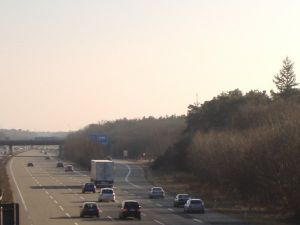Proposal:Lane and lane group
(Redirected from Proposed features/lane and lane group)
Jump to navigation
Jump to search
| This proposal has been obsoleted by Lanes. |
| lane and lane group | |
|---|---|
| Proposal status: | Obsoleted (inactive) |
| Proposed by: | Tordanik |
| Tagging: | ?=? |
| Applies to: | ? |
| Definition: | ? |
| Statistics: |
|
| Rendered as: | ? |
| Draft started: | 2008-12-30 |
This proposal tries to establish a concept for mapping “lanes” – all sorts of (almost) parallel way parts, such as cycleways, pavements or car lanes.
Objectives
This proposal was set up with the following primary objectives in mind:
- Reusing existing tags for maxspeed, access, surface, width …
- Specifying full lane ordering. Example: The mapper should be able to not only express that cycleway and footway are both on the “left” side of the street, but also which of the two is further to the left.
- Creating lanes with own geometries, e.g. for detailed mapping of complicated junctions.
- Creating lanes without own geometries, e.g. for streets with perfectly parallel lanes where separate ways would make moving the street and similar actions unnecessarily difficult.
- Compatibility with advanced information, such as lanes that connect to different streets and lane-specific turn restrictions. Example: In some situations (e.g. motorway junctions), it is helpful to know which lanes are intended for traveling straight on and which are intended for leaving the street. Ideally, an OSM-based navigation system could provide lane hints to a driver.
Concept
The features this proposal is based on are lanes (as lane ways or lane relations) and lane groups.
- A lane way represents a single lane. It is tagged with the key
laneand one of the values from the table at #lane values. With the exception of having a lane tag instead of a highway tag, this way can be tagged as usual, e.g. with access=*, surface=* …
- A lane relation is an alternative to the lane way. It also represents a single lane, which is assumed to represent a lane parallel to the highway referenced in the lane_group. A lane relation needs no members and is tagged with type=lane. All other tags can be used as if it was a lane way.
- A lane_group relation connects a highway and its lanes. It is tagged with type=lane_group and has the lanes and the highway as members (see #lane_group relation members).
lane values
The value of the lane-key indicates the type of traffic the lane is intended for.
| Value | Description | Implied access information |
|---|---|---|
| footway | for pedestrians | foot=designated |
| cycleway | for cyclists | bicycle=designated |
| vehicle_lane | for vehicles such as cars and hgv, by default also for bicycles | vehicle=designated |
| bus_lane | lane where busses can drive and/or stop | psv=designated |
By default, the lane is not available to any type of traffic that is not listed (access=no).
Note: This list is most probably incomplete and might require changes. Please use the talk page to comment on and discuss these values.
lane_group relation members
Examples
| Description | JOSM view | JOSM lanetool view | File link |
|---|---|---|---|
| two-lane road with a cycleway for each direction and a single footway. The mapper decided to draw one of the cycleways as an own way. The lanes have different surfaces (asphalt, cobblestone on the footway) and widths. See details ... |
 |
 |
.osm file |
| TODO: more examples |
See also
- lanetool – experimental prototype of lane_group editing plugin for JOSM
- a bit of research into those proposals that currently touch the multilane-problem
- User:Ömmes/Wayparts - combines some features of different lane proposals

